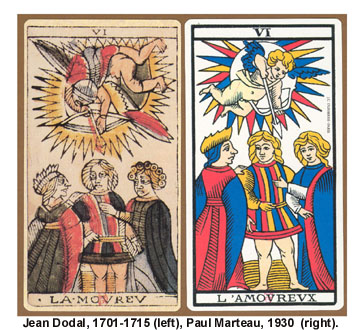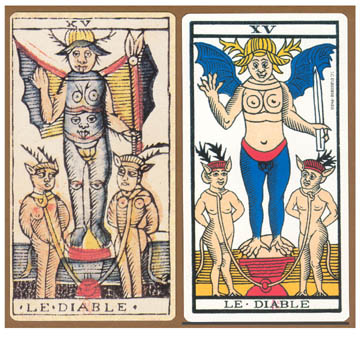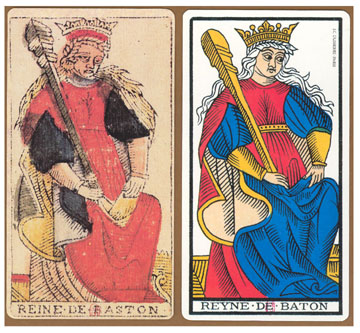|
 Editions Dusserre, Paris, has reissued two different editions of the famous Tarot de Marseille pattern,
by many occultists considered as being the only genuine Tarot pack.
Editions Dusserre, Paris, has reissued two different editions of the famous Tarot de Marseille pattern,
by many occultists considered as being the only genuine Tarot pack.
 One of the two packs is a reprint of the oldest complete Marseille-pack kept in the collections of
Biblioteque National in Paris. The pack was originally printed by the card maker Jean Dodal, who worked
in Lyon from 1701 to 1715. Even though it is not the same feeling as having an original and ancient pack
in your hands, there is a need for reprints, documenting the history of Tarot. Looking at the pictures
in this deck, it is amazing to think, that Jean Dodal made this pack at a time, when Court de Gebelin
still had not given his (now obviously false) theory of the Egyptian origin of the tarot and with
this had given the starting signal for the "esoteric "tarot", which is now part of so many people's daily
life. The tarot pack, that Gebelin noticed being played with and which started all this, might very well
have looked like this one.
One of the two packs is a reprint of the oldest complete Marseille-pack kept in the collections of
Biblioteque National in Paris. The pack was originally printed by the card maker Jean Dodal, who worked
in Lyon from 1701 to 1715. Even though it is not the same feeling as having an original and ancient pack
in your hands, there is a need for reprints, documenting the history of Tarot. Looking at the pictures
in this deck, it is amazing to think, that Jean Dodal made this pack at a time, when Court de Gebelin
still had not given his (now obviously false) theory of the Egyptian origin of the tarot and with
this had given the starting signal for the "esoteric "tarot", which is now part of so many people's daily
life. The tarot pack, that Gebelin noticed being played with and which started all this, might very well
have looked like this one.
 The Jean Dodal pack is originally woodblock printed and stencil colored in those green, yellow, red and
blue colors, which are usually found in decks with this pattern. It has all the traditional figures,
including the Pope and Popess (which here is spelled "La Pances"). The two of cups and the two of coins
wear the cardmaker's name. Several cards have an additional text "F.P.LE.TRANGE", which tells us that
this pack was not intended to be used in France, but "Fait pour l'étranger" - made for export. If you
want to have a pack in your collection, which is close to the tarot pattern that inspired the 18th
century fortune-tellers and occultists, this is a good choice (and the price is modest).
The Jean Dodal pack is originally woodblock printed and stencil colored in those green, yellow, red and
blue colors, which are usually found in decks with this pattern. It has all the traditional figures,
including the Pope and Popess (which here is spelled "La Pances"). The two of cups and the two of coins
wear the cardmaker's name. Several cards have an additional text "F.P.LE.TRANGE", which tells us that
this pack was not intended to be used in France, but "Fait pour l'étranger" - made for export. If you
want to have a pack in your collection, which is close to the tarot pattern that inspired the 18th
century fortune-tellers and occultists, this is a good choice (and the price is modest).
 The second Marseille pack from Editions Dusserre is "Le Tarot de Marseille de Paul Marteau", which gives
us the opportunity to compare the ancient Marseille pattern with the now well-known one, which is a
revised edition by Paul Marteau, first printed in 1930. Paul Marteau was a card historian, a collector
of playing cards, in which he followed his uncle, Georges Marteau. The collections of Georges and Paul
Marteau are now the basis for the French Biblioteque Nationale's collection. Paul Marteau was also a
card manufacturer, a grandnephew of Baptiste-Paul Grimaud (1817-1899). In 1920 he took over the management
of the family business (founded in the mid-19th century) at the death of his father, Leo Marteau, who
was a brother to Georges Marteau. Paul Marteau, who had a doctor's degree in philosophy, was intrigued
by the ancient Marseille pattern and by tarot symbolism. In his restoration, he stayed with the original
pattern, concentrating to clarify the forms and the colors. The result of this work is the Grimaud
edition of the Marseilles pattern, which is what most tarotists nowadays believe is The Marseilles
pattern. In 1949 Paul Marteau's treatise on the symbolism of the Marseille "Le Tarot de Marseille",
was published, an exclusive book with glued-on colored prints of all 78 cards. Paul Marteau died in 1966.
The second Marseille pack from Editions Dusserre is "Le Tarot de Marseille de Paul Marteau", which gives
us the opportunity to compare the ancient Marseille pattern with the now well-known one, which is a
revised edition by Paul Marteau, first printed in 1930. Paul Marteau was a card historian, a collector
of playing cards, in which he followed his uncle, Georges Marteau. The collections of Georges and Paul
Marteau are now the basis for the French Biblioteque Nationale's collection. Paul Marteau was also a
card manufacturer, a grandnephew of Baptiste-Paul Grimaud (1817-1899). In 1920 he took over the management
of the family business (founded in the mid-19th century) at the death of his father, Leo Marteau, who
was a brother to Georges Marteau. Paul Marteau, who had a doctor's degree in philosophy, was intrigued
by the ancient Marseille pattern and by tarot symbolism. In his restoration, he stayed with the original
pattern, concentrating to clarify the forms and the colors. The result of this work is the Grimaud
edition of the Marseilles pattern, which is what most tarotists nowadays believe is The Marseilles
pattern. In 1949 Paul Marteau's treatise on the symbolism of the Marseille "Le Tarot de Marseille",
was published, an exclusive book with glued-on colored prints of all 78 cards. Paul Marteau died in 1966.
The pack at hand is Edition Dusserre's reproduction of the Paul Marteau pack printed in 1930, a pack equal
to the well-known Grimaud edition, except that the cardboard used is thinner and the colors lighter,
particularly the pink.
|